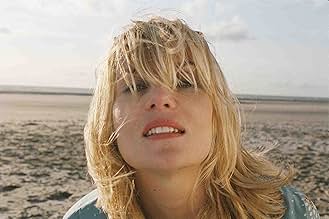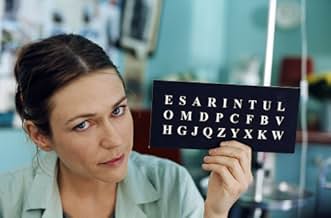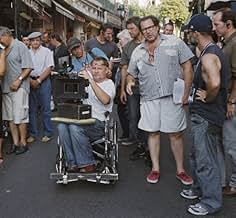IMDb रेटिंग
8.0/10
1.1 लाख
आपकी रेटिंग
अपनी भाषा में प्लॉट जोड़ेंThe true story of Elle editor Jean-Dominique Bauby who suffers a stroke and has to live with an almost totally paralyzed body; only his left eye isn't paralyzed.The true story of Elle editor Jean-Dominique Bauby who suffers a stroke and has to live with an almost totally paralyzed body; only his left eye isn't paralyzed.The true story of Elle editor Jean-Dominique Bauby who suffers a stroke and has to live with an almost totally paralyzed body; only his left eye isn't paralyzed.
- 4 ऑस्कर के लिए नामांकित
- 68 जीत और कुल 106 नामांकन
कहानी
क्या आपको पता है
- ट्रिवियाTo familiarize himself with Bauby's sheltered existence, director Julian Schnabel made the movie in the same hospital where Bauby was treated, meeting many of the orderlies who had treated him. He also shot scenes on the same balcony where Bauby relaxed, and on the same nearby beach to which his family had taken him.
- गूफ़When Jean-Dominique goes on a boat ride, a 'Speedferries' vessel can be seen in the background. Speedferries started business in 2004, years after the movie was set.
- भाव
Jean-Dominique Bauby: I decided to stop pitying myself. Other than my eye, two things aren't paralyzed, my imagination and my memory.
- साउंडट्रैकTheme for The Diving-Bell and the Butterfly
Composed by Paul Cantelon
Studio recording The University of Victoria
Engineer / Producer Russell Dawkin
फीचर्ड रिव्यू
Though not paralyzed from head to toe like French fashion magazine editor Jean-Dominique Bauby, many of us are in the "locked-in" syndrome locked into our resentments and our fears, a rigidity that sours us on life and keep us estranged from family and friends. Julian Schnabel's masterful The Diving Bell and the Butterfly allows us to better appreciate the simple pleasures in life by dramatizing the debilitating trauma faced by the 43-year old editor who suffered a massive stroke that left him unable to speak or to move his head and whose only means of communication was to blink one eye one blink for yes, two blinks for no.
Beautifully shot by cinematographer Janusz Kaminski with a screenplay by Ronald Harwood, the film begins with Bauby's confused awakening in the hospital after twenty days in a coma. We see only a blur of images and claustrophobic close-ups that mirror the patient's mental state. We can make out a hospital room and doctors and nurses offering reassuring thoughts. We hear Bauby's words but the doctors do not and we know that while his body isn't functioning, his mind is as sharp as ever. With the help of a speech therapist (Marie-Josée Croze), and a very patient transcriber, a code is developed that allows Bauby (Mathieu Amalric), called Jean-Do by his friends and family, to compose a book based on his experience.
When the therapist recites the most-frequently used letters in the French alphabet, Bauby blinks when he wants to choose a letter. The book, on which the film is based, was published in 1997, shortly after Bauby's death. One of the most dramatic moments in the film occurs near the beginning when the first thought Jean-Do communicates is that he wants to die. Feeling rejected and angry, the therapist stomps out of the room but apologizes and comes back shortly to resume the treatment. We do not actually see Jean-Do until about a third of the way through the film but we can hear his thoughts which are in turn angry, funny, and bitterly ironic. Bauby compares his body to a deep-sea diver being suffocated in a diving suit and his poetic imagination to a butterfly.
It is Jean-Do's sense of humor that keeps the film as light as it can be under the circumstances and his eloquence that keeps us riveted. When we finally do see him with his immobile body and his drooping lower lip, it is still a shock but we smile when he says that "I look like I came out of a vat of formaldehyde." Much of the film vividly explores the editor's imagination and the camera takes us on some wild rides that include images of Nijinsky, Empress Eugénie, Marlon Brando, and Jean-Do in his imagination skiing and surfing. Some of the most emotional moments occur when he greets his young children at the beach for the first time after his stroke, a telephone "conversation" with his 92-year old father (Max Von Sydow), and flashbacks to his youth - driving with his girlfriend, shaving his father, supervising a fashion shoot, and taking his son on a trip in a new sports car. Bauby's wife Céline (Emmanuelle Seigner), whom he left for exotic girlfriend Ines (Agathe de La Fontaine), visits him in the hospital and comforts him while Ines cannot bring herself to see him, saying that she wants to remember him the way he was.
Realizing how his life had been less than exemplary, his stroke becomes an opportunity for redemption and allows him, if not to cleanse his soul, to discover that humanity lies in his consciousness not in material things or sexuality. The Diving Bell and the Butterfly is a film of enormous power that shakes us and enables us to get in touch with the miracle of each moment. Schnabel says that his purpose in making the film was to tell "the story of all of us, who surely do face death and sickness. But if we look", he says, "we can find meaning and beauty here." There is enough of both meaning and beauty to make The Diving Bell and the Butterfly one of the best films of the year.
Beautifully shot by cinematographer Janusz Kaminski with a screenplay by Ronald Harwood, the film begins with Bauby's confused awakening in the hospital after twenty days in a coma. We see only a blur of images and claustrophobic close-ups that mirror the patient's mental state. We can make out a hospital room and doctors and nurses offering reassuring thoughts. We hear Bauby's words but the doctors do not and we know that while his body isn't functioning, his mind is as sharp as ever. With the help of a speech therapist (Marie-Josée Croze), and a very patient transcriber, a code is developed that allows Bauby (Mathieu Amalric), called Jean-Do by his friends and family, to compose a book based on his experience.
When the therapist recites the most-frequently used letters in the French alphabet, Bauby blinks when he wants to choose a letter. The book, on which the film is based, was published in 1997, shortly after Bauby's death. One of the most dramatic moments in the film occurs near the beginning when the first thought Jean-Do communicates is that he wants to die. Feeling rejected and angry, the therapist stomps out of the room but apologizes and comes back shortly to resume the treatment. We do not actually see Jean-Do until about a third of the way through the film but we can hear his thoughts which are in turn angry, funny, and bitterly ironic. Bauby compares his body to a deep-sea diver being suffocated in a diving suit and his poetic imagination to a butterfly.
It is Jean-Do's sense of humor that keeps the film as light as it can be under the circumstances and his eloquence that keeps us riveted. When we finally do see him with his immobile body and his drooping lower lip, it is still a shock but we smile when he says that "I look like I came out of a vat of formaldehyde." Much of the film vividly explores the editor's imagination and the camera takes us on some wild rides that include images of Nijinsky, Empress Eugénie, Marlon Brando, and Jean-Do in his imagination skiing and surfing. Some of the most emotional moments occur when he greets his young children at the beach for the first time after his stroke, a telephone "conversation" with his 92-year old father (Max Von Sydow), and flashbacks to his youth - driving with his girlfriend, shaving his father, supervising a fashion shoot, and taking his son on a trip in a new sports car. Bauby's wife Céline (Emmanuelle Seigner), whom he left for exotic girlfriend Ines (Agathe de La Fontaine), visits him in the hospital and comforts him while Ines cannot bring herself to see him, saying that she wants to remember him the way he was.
Realizing how his life had been less than exemplary, his stroke becomes an opportunity for redemption and allows him, if not to cleanse his soul, to discover that humanity lies in his consciousness not in material things or sexuality. The Diving Bell and the Butterfly is a film of enormous power that shakes us and enables us to get in touch with the miracle of each moment. Schnabel says that his purpose in making the film was to tell "the story of all of us, who surely do face death and sickness. But if we look", he says, "we can find meaning and beauty here." There is enough of both meaning and beauty to make The Diving Bell and the Butterfly one of the best films of the year.
- howard.schumann
- 11 जन॰ 2008
- परमालिंक
टॉप पसंद
रेटिंग देने के लिए साइन-इन करें और वैयक्तिकृत सुझावों के लिए वॉचलिस्ट करें
विवरण
- रिलीज़ की तारीख़
- कंट्री ऑफ़ ओरिजिन
- आधिकारिक साइटें
- भाषा
- इस रूप में भी जाना जाता है
- Le Scaphandre Et Le Papillon
- फ़िल्माने की जगहें
- उत्पादन कंपनियां
- IMDbPro पर और कंपनी क्रेडिट देखें
बॉक्स ऑफ़िस
- US और कनाडा में सकल
- $60,03,227
- US और कनाडा में पहले सप्ताह में कुल कमाई
- $75,721
- 2 दिस॰ 2007
- दुनिया भर में सकल
- $1,97,80,116
- चलने की अवधि1 घंटा 52 मिनट
- रंग
- ध्वनि मिश्रण
- पक्ष अनुपात
- 1.85 : 1
इस पेज में योगदान दें
किसी बदलाव का सुझाव दें या अनुपलब्ध कॉन्टेंट जोड़ें





























